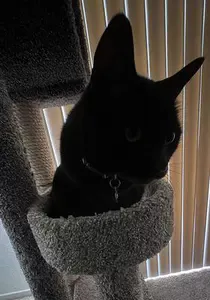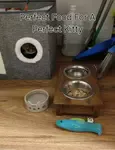The American Bobtail: Bobcat Blood Or Tall Tales?
The American Bobtail got its start in the 1960s, but the history of this cat is a bit bumpy. Any claims of wild bobcat blood in the breed are, to my knowledge, unfounded.
It took over 30 years for this cat to be recognized as a breed by the CFA. Creating a new cat breed and getting it accepted is a long and difficult process, but that's a long time even by Cat Fancy standards.
Stops and starts in the breeding, too much inbreeding of the original lines, and vague stories about wild bobcats probably didn't help.
The exact origin of the breed is uncertain. More on that in a moment. The question on everyone's mind is...
Is there bobcat blood in the American Bobtail line?
The CFA breed article doesn't even mention the possibility of this breed having bobcat lineage, only that these cats look like bobcats.
And they do. This is a muscular cat with a short tail, a wild look, and a "hunting gaze." In contrast to that, they actually make great family pets.
The Manx can be completely tailless and still be able to compete in the show ring. The American Bobtail, however, must have a tail, if a short one. The tail should be short enough to stop before it reaches the cat's hocks.
Many domestic cats have a sleek, slender appearance, with lines similar to a cheetah. While sleekness is definitely a built-in cat quality, many wild cats have a much stockier, large pawed look, more like a cougar or a lion.
The American Bobtail is more like its stockier wild cousins, with the standard calling for a stocky, muscular cat with big paws. This cat's head is wedge shaped, but broader than "normal."
These qualities, along with a rather ruffled looking coat, give it its slightly wild look. The lonhaired version of this cat can be quite striking looking.
The Bobtail can come in any color. The most commonly seen, however, are fawn and white, blue tabby, red tabby, and brown tabby.
The strange history of the American Bobtail cat breed
Considered the "father" of the first American Bobtail lines, the original cat of this breed was named Yodie, a stray male brown tabby cat with a short tail. Because he was a stray, his origin is unknown, but apparently it was assumed there was some bobcat blood in his lineage.
Yodie was found near an Indian reservation by a couple from Iowa named John and Brenda Sanders who were on vacation in Arizona. They brought Yodie back to Iowa with them, where he mated with a seal point Siamese cat. Cats of other breeds, including Birman, Himalayan, and a Himalayan/Siamese mix were then added into the mix as crosses.
Note that all of these cats (except Yodie) have some Siamese in the blood, so the proportion of Siamese genes is heavy. The original American Bobtail line was, in fact, intended to be a short-tailed pointed longhair, with white mittens and a white face blaze.
I've never seen one of these original Bobtail cats, but I envision it as sort of a longhaired Snowshoe cat, but with a short tail.
The complexity of creating that exact mix of fantastic feline features was apparently daunting. Feline genetics is not easy, and over the years, many cat breeders have gotten many surprises.
In the case of the American Bobtail, the original line became too inbred. This is one of the downsides to experimental breeding. Along with that sometimes come various health issues when a breed is first developed.
But in the 1980s, a group of breeders broke off from the original concept and these days, the American Bobtail comes in all variety of colors and patterns. As always, devoted breeders worked to ensure that most health problems were solved. Today, the Bobtail is a strong, sturdy cat.
With the new line of American Bobtail, however, came more stories of bobcat and domestic cat matings, but none of these were ever confirmed as far as I know.
Eventually, these kitties achieved recognition and acceptance and are now able to compete in the CFA Championship breed class.
Modern American Bobtails are both very friendly, and somewhat nosy. Because of this, they are prone to getting into mischief if they are unsupervised and become bored.
The Bobtail's outgoing temperament makes this breed an ideal choice for families. If you socialize your kitten from a young age, she should actually look forward to having friends and family visit. Make sure your breeder has good socialization practices for their cats.
Since this breed is fairly sociable, you may also want to add a second cat to the household so your kitty has a playmate. Yes, as I'm fond of saying, two cats are better than one!
The shorthaired version of these cats should be groomed at least once a week. Although the longhair coat does not tangle easily, you may need to groom your longhair Bobtail more frequently. If you accustom your kitten to the grooming process when she is young, she should grow to enjoy the attention.
If you're interested in a cat who is friendly, sweet and sociable, but has that wild look, then the American Bobtail may just be the ideal breed for you.
If you're interested in short tailed cats, you might want to have a look at the Japanese Bobtail. If you like the idea of having a big house cat around, you might be interested in these other large and sturdy cats:


Comments: What do you think?
Have your say about what you just read. Leave me a comment in the box below.